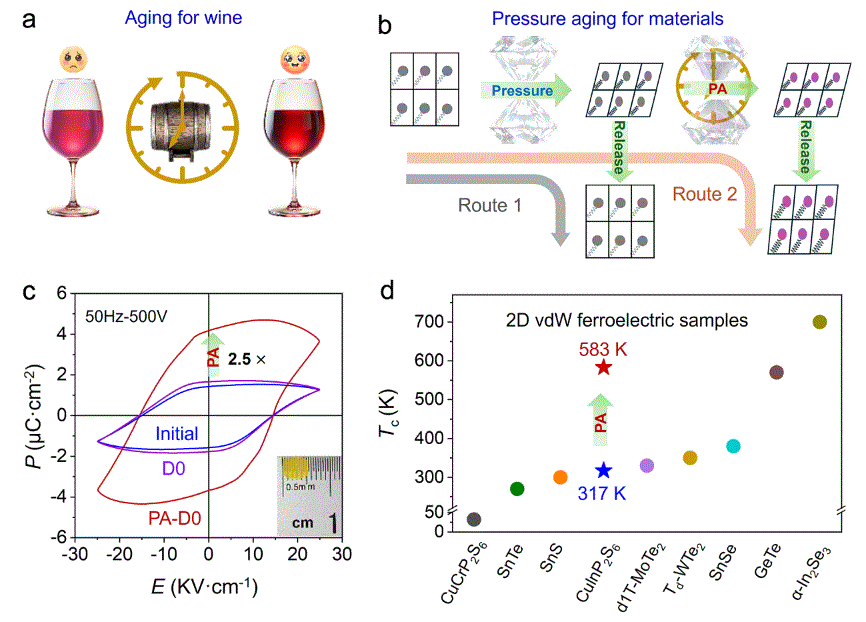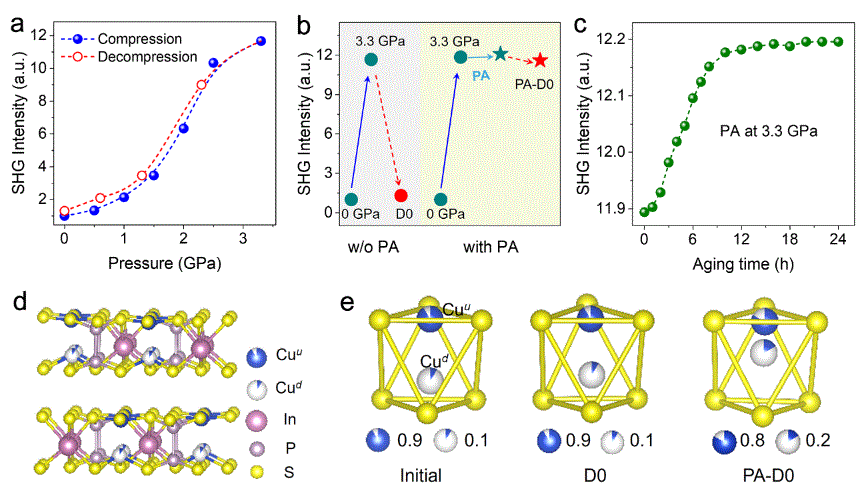
In the field of high-pressure research, a long-standing challenge has been the preservation of desirable material characteristics obtained under high pressure. Typically, pressure-induced changes are reversible once the pressure is released, limiting the practical applications of these materials. However, a recent study published in PNAS proposes the concept of “pressure aging” (PA), which offers a novel solution to this problem. This research, led by Prof. Ho-Kwang Mao and Xujie Lü from the Center for High Pressure Science and Technology Advanced Research, presents a significant advancement with far-reaching implications for materials science.
The researchers demonstrated the concept of PA using the two-dimensional ferroelectric CuInP₂S₆ (Figure 1). By subjecting the material to 3.3 GPa for 24 hours, they achieved a permanent change in the Cu configuration. This led to a remarkable 2.5-fold increase in remanent polarization and a significant boost in the Curie temperature (Tc) from 317 K to 583 K. In contrast, samples that underwent a simple compression-decompression cycle without PA showed only negligible or reversible changes in their characteristics.

Figure 1. The concept of pressure aging (PA) and its impacts on materials such as CuInP2S6. a) Aging or ripening process used in food industry like wine. b) Illustration of PA strategy for materials that exhibits remarkable impact on the structures. c) 2.5-fold enhancement in the remanent polarization of ferroelectric CuInP2S6 after the PA treatment, whereas the sample without PA shows negligible change. d) 266 K increase of Tc from 317 K to 583 K for CuInP2S6 and the comparison with other 2D ferroelectric materials.
Through a combination of in situ experimental techniques such as single-crystal X-ray diffraction (XRD) and Raman spectroscopy, the team elucidated the structural modifications induced by PA. XRD analysis revealed that the Cu position and the Cu-upward/Cu-downward ratio in CuInP₂S₆ exhibited significant changes after PA treatment and pressure release (Figure 2). Raman spectroscopy provided further evidence of the irreversible shifts in certain vibrational modes, confirming the retained structural changes. These findings highlight the ability of PA to induce lasting alterations at the atomic scale.

Figure 2. The variations of SHG property and structure of CuInP2S6 during pressure treatments with and without PA. (a) Pressure-dependent SHG intensity of CuInP2S6, which shows reversible evolution throughout the compression and decompression cycle without the PA process. (b) Comparative analysis of the distinct variations of SHG during compression and decompression with and without PA. (c) The time-dependent evolution of SHG intensities during the PA treatment at 3.3 GPa. (d) The crystal structures of CuInP2S6 at initial conditions. (e) Comparative analysis of the variations of Cuu/Cud ratio and position at the initial state, after the pressure treatment with and without the PA process.
The relaxation dynamics during PA were investigated using the Kohlrausch–Williams–Watts (KWW) function. The analysis showed that both the structural (Raman) and property (SHG) relaxation processes could be effectively described by this function. The relaxation time (τ) was determined to be around 6 hours, and the PA exponent (β) was approximately 1.5, consistent with values observed in relatively soft materials. This understanding of the relaxation process provides valuable insights into the temporal evolution of the changes during PA.
The significance of the PA strategy was further demonstrated with a diverse range of materials, including 3D MHyPbBr₃, 2D (BA)₂(GA)Pb₂I₇, 1D (CH₃CH₂CH₂NH₃)₂SbBr₅, and 0D (MePh₃P)₂SbCl₅ (Figure 3). In all these systems, PA treatment led to permanent property improvements after pressure release, while samples without PA exhibited only reversible variations. For example, MHyPbBr₃ showed a ten-fold increase in SHG intensity, and (BA)₂(GA)Pb₂I₇ demonstrated a two-fold increase in PL intensity.

Figure 3. The applicability of PA strategy for various materials. (a) The implementation of PA strategy leads to significant improvements in the properties of diverse materials. The designations 1 to 5 correspond to the materials of 3D MHyPbBr3, 2D (BA)2(GA)Pb2I7, 2D CuInP2S6, 1D (CH3CH2CH2NH3)2SbBr5, and 0D (MePh3P)2SbCl5, respectively. (b) The illustration of potential mechanism for the PA recovery process.
The PA process involves the application of pressure for a specific duration, during which the material undergoes structural rearrangements. High-pressure conditions cause the atoms, particularly Cu cations in the case of CuInP₂S₆, to move and reach a new equilibrium state. As the pressure is maintained over time, these new configurations become more stable. When the pressure is finally released, the material retains a significant portion of these structural changes, leading to the observed enhancements in properties. The KWW function analysis indicates that the relaxation process is time-dependent and involves different response rates for various components of the materials.
The concept of “pressure aging” introduces a groundbreaking new approach to high-pressure materials research. By emphasizing the importance of the duration at desired pressures, it offers a way to unlock and permanently preserve the enhanced properties of materials. This has the potential to revolutionize the exploration and engineering of functional materials with optimized structures. The broad applicability of the PA strategy across different structural dimensionalities and material systems showcases its versatility. It provides a unified framework for understanding and manipulating the properties of a wide variety of materials, opening up new avenues for materials discovery and design.
高压是发现新材料和新现象的有效途径。如何保留在高压下获得的理想材料特性,是高压研究领域长期存在的一个挑战,因为压力诱导的变化往往是可逆的,这限制了高压新材料的应用潜力。近期,发表于 《美国科学院院刊》PNAS 的一项研究提出了 “压力陈化”(Pressure Aging)的新概念,可以将高压下的材料结构及其增强性能部分锁定至常压条件,从而为解决上述问题提供了新的途径。这项由北京高压科学研究中心毛河光院士团队吕旭杰研究员课题组取得的重要研究成果,将对高压化学和材料科学产生深远的影响。